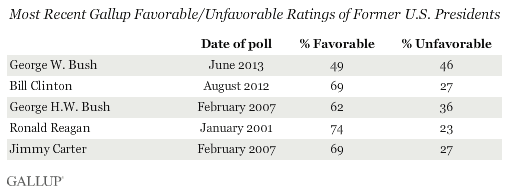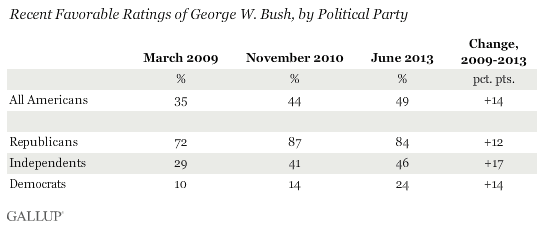PRINCETON, NJ -- Americans' views of former president George W. Bush have improved, with 49% now viewing him favorably and 46% unfavorably. That is the first time since 2005 that opinions of him have been more positive than negative.

Bush has maintained a fairly low profile in the four years since he left office. However, he returned to the public eye this year with the April opening of his presidential library at Southern Methodist University in Dallas.
Bush left office with 40% viewing him favorably and 59% unfavorably in January 2009. That worsened to 35% favorable and 63% unfavorable in March 2009, but his favorable rating recovered to the mid-40% range by 2010.
The June 1-4 poll shows further improvement in Americans' ratings of Bush, which had not been more positive than negative since April 2005. Prior to then, Americans had always viewed Bush more favorably than unfavorably, including an 87% favorable rating in November 2001 after the 9/11 terrorist attacks. That is one percentage point below the all-time high Gallup has measured for any public figure, shared by Colin Powell (2002) and Tiger Woods (2000).
Bush's lowest favorable rating was 32% in April 2008, as the economy was in recession and gas prices were headed toward record highs in the U.S. Also at the time, Hillary Clinton and Barack Obama were engaged in a spirited campaign to become the Democratic nominee who would run for president to succeed Bush.
Americans Generally Kind to Ex-Presidents
The recovery in Bush's image is not unexpected, given that Americans generally view former presidents positively. Gallup's favorable ratings for Ronald Reagan, Jimmy Carter, George H.W. Bush, and Bill Clinton all exceeded 60% when last measured.

George W. Bush's lower rating may be due to his shorter time as an ex-president. For example, Clinton's favorable rating, which dropped as low as 39% in the months after he left office, recovered to 56% roughly four years later -- still better than George W. Bush's current 49%, but not as positive as Clinton's more recent ratings. Gallup did not measure favorable ratings in the current format for presidents prior to 1992. Its first post-presidency measure for the elder George Bush came eight years after he left office.
Bush More Popular Among All Party Groups Since 2009
George W. Bush's favorable rating is more positive now among all party groups than it was in March 2009, when it dipped to 35% overall. Currently, 84% of Republicans, 46% of independents, and 24% of Democrats have a favorable view of Bush, each up more than 10 points since 2009. However, the more recent improvement in his ratings, a five-point overall uptick since November 2010, has been more apparent among Democrats, whose rating has increased by 10 points since then.

Opinions of Bush still show a high degree of party polarization, with a 60-point gap in his favorable ratings from Republicans versus Democrats. Party polarization marked Bush's ratings while he was in office as well. His job approval ratings were the most polarized for a president prior to Barack Obama.
Implications
Americans' opinions of George W. Bush have improved with the passage of time, and now the public's ratings of the former president tilt positive. Bush left office with decidedly negative favorability ratings as well as approval ratings, so the recovery in his image is notable.
The improvement is not unexpected, though, given Americans' generally positive views of former presidents, and it would not be out of the question for Bush's image to continue to improve in future years. But Bush's image improved more from 2009 to 2010 than it has in the past three years, even with a recent round of positive publicity from the opening of his presidential library, so that is not a guarantee he will see the 60%+ favorable ratings enjoyed by other former presidents anytime soon.
Survey Methods
Results for this Gallup poll are based on telephone interviews conducted June 1-4, 2013, with a random sample of 1,529 adults, aged 18 and older, living in all 50 U.S. states and the District of Columbia.
For results based on the total sample of national adults, one can say with 95% confidence that the margin of sampling error is ±3 percentage points.
Interviews are conducted with respondents on landline telephones and cellular phones, with interviews conducted in Spanish for respondents who are primarily Spanish-speaking. Each sample of national adults includes a minimum quota of 50% cellphone respondents and 50% landline respondents, with additional minimum quotas by region. Landline telephone numbers are chosen at random among listed telephone numbers. Cellphone numbers are selected using random digit dial methods. Landline respondents are chosen at random within each household on the basis of which member had the most recent birthday.
Samples are weighted to correct for unequal selection probability, nonresponse, and double coverage of landline and cell users in the two sampling frames. They are also weighted to match the national demographics of gender, age, race, Hispanic ethnicity, education, region, population density, and phone status (cellphone only/landline only/both, cellphone mostly, and having an unlisted landline number). Demographic weighting targets are based on the March 2012 Current Population Survey figures for the aged 18 and older U.S. population. Phone status targets are based on the July-December 2011 National Health Interview Survey. Population density targets are based on the 2010 census. All reported margins of sampling error include the computed design effects for weighting.
In addition to sampling error, question wording and practical difficulties in conducting surveys can introduce error or bias into the findings of public opinion polls.
View methodology, full question results, and trend data.
For more details on Gallup's polling methodology, visit www.gallup.com.
